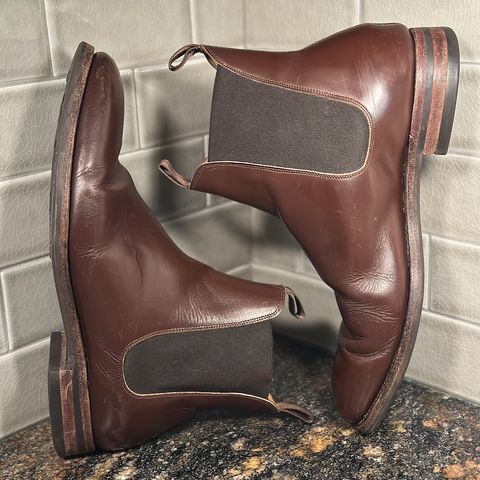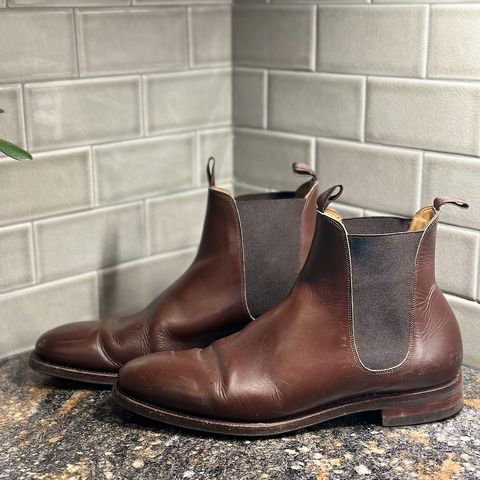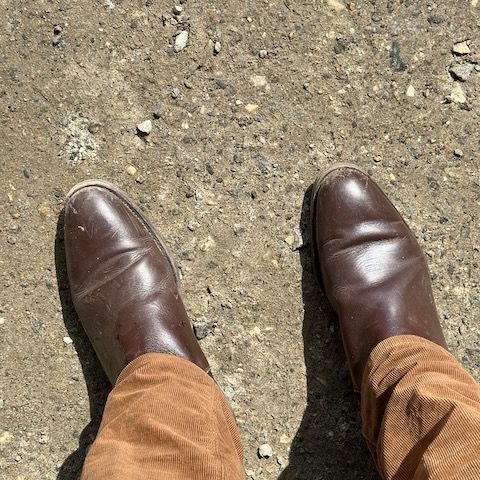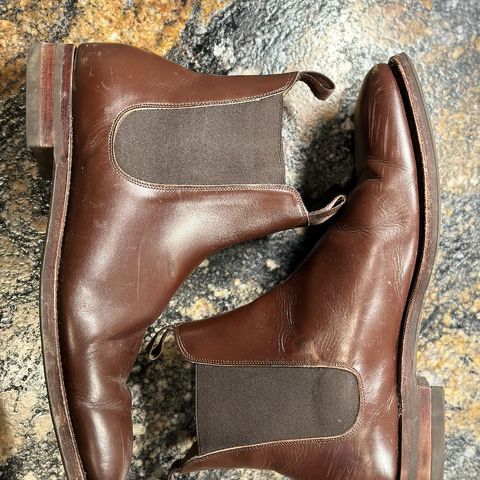About
Du Puy Brown Box Calf is a smooth, firm calf leather featuring traditional brown coloration, produced by Tanneries du Puy through chrome tanning with aniline dyeing. The brown variant represents the application of classic warm-toned coloring to Du Puy Box Calf, combining the leather's characteristic fine grain structure and natural suppleness with versatile brown tones suitable for both formal and casual footwear applications.
About
Du Puy Brown Box Calf is a smooth, firm calf leather featuring traditional brown coloration, produced by Tanneries du Puy through chrome tanning with aniline dyeing. The brown variant represents the application of classic warm-toned coloring to Du Puy Box Calf, combining the leather's characteristic fine grain structure and natural suppleness with versatile brown tones suitable for both formal and casual footwear applications.
The aniline dyeing process used for brown box calf involves immersing the leather in a transparent dye bath that penetrates throughout the material while allowing the natural grain and markings to remain visible. This approach creates rich, deep brown coloring that enhances the leather's natural beauty while maintaining the visibility of its grain structure. The full-grain construction and specialized tanning process enable the leather to develop a distinctive patina as it ages with wear, with brown tones deepening and enriching over time.
Brown Coloration Process
The brown coloration in Du Puy box calf is achieved through aniline dyeing, where transparent brown dyes penetrate the chrome-tanned leather structure. This dyeing method preserves the natural characteristics of the calf hide while imparting the desired brown color throughout the material. The aniline process maintains the leather's grain visibility and natural markings, resulting in a semi-transparent finish that showcases the inherent qualities of the hide beneath the brown coloring.
Du Puy's production capabilities include over 300 available finishes, allowing for various brown shade options within their box calf offerings. The finishing stage of production permits customization of color depth, shine levels ranging from matte to glossy, and controlled suppleness while maintaining the fundamental brown coloration. Each hide undergoes rigorous quality control inspection to ensure color accuracy and consistency across the finished brown box calf leather.
Aging and Patina Development
Brown box calf from Du Puy develops patina through extended use and maintenance, with the leather's surface becoming weathered and aged in ways that enhance its visual appeal. The patina development process indicates the leather has experienced extensive wear and received numerous applications of wax and polish over time. Natural patina formation in brown box calf typically requires months or years of regular use to become pronounced.
The aging process causes darker brown areas to develop through repeated polishing over worn sections and the absorption of oils and dyes, particularly along seams and high-wear areas. The cellular structure of the leather surface becomes more exposed through repeated buffing of the toe box and flexing of other areas, contributing to the evolving appearance of the brown coloration. Chrome-tanned aniline-dyed leather maintains its ability to develop attractive patina over time, with brown tones becoming increasingly rich and complex as the leather ages.
Traditional Footwear Applications
Brown box calf represents one of the most traditional leather choices for dress shoes and has been widely used in footwear manufacturing since the mid-twentieth century. The brown coloration provides warm, rich tones that offer exceptional versatility in style coordination, making the leather suitable for both casual and formal shoe applications. Most dress shoes featuring uniform brown finish utilize box calf leather due to its consistent appearance and reliable performance characteristics.
The versatile nature of brown coloring allows it to complement a wide range of clothing styles and color palettes, contributing to its status as a perpetual favorite in high-quality footwear manufacturing. Traditional heritage footwear designs frequently incorporate brown box calf where classic aesthetics combine with proven material performance. The leather's medium-weight classification at 1.2 to 1.4 millimeters thickness makes it appropriate for various footwear construction methods while maintaining structural integrity.
Care and Maintenance
Maintaining brown box calf requires regular cleaning and conditioning to support both the leather's structural properties and its color preservation. The natural aging characteristics of brown box calf mean that proper maintenance enhances rather than prevents the development of patina, supporting the evolution of the leather's appearance while protecting against damage or premature wear. Regular applications of quality leather care products help maintain the rich brown coloration while ensuring the leather remains flexible and durable.
The surface of brown box calf responds to polishing and buffing, with accumulated layers of wax and polish contributing to the development of patina over time. Care routines should focus on preserving the leather's suppleness and grain quality while allowing the natural aging process to enhance the brown coloration. The full-grain structure of the leather benefits from conditioning treatments that penetrate the material and support its long-term performance in footwear applications.
References
"Box Calf Leather: An Unraveling of its Timeless Appeal". Manuel Dreesmann. Retrieved October 28, 2025.
"Box Calf: Aniline Semi-Rigid Calfskin Leather". BuyLeatherOnline. Retrieved October 28, 2025.
Mooney, Patrick. "How to Patina Leather Shoes". FootFitter. Retrieved October 28, 2025.
"Tanneries du Puy". Groupe HCP. Retrieved October 28, 2025.





































































